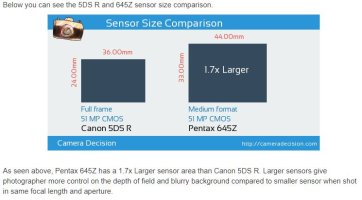Antono Refa said:
gsealy said:
You say why spend $6500 on that camera? ... where can I get the money to buy it.
Ah, yes, that's why.
Medium Format has a place, and that place
is to be markedly better than FF. But the two current mirrorless MF offerings of late -- the Hass'y and Fuji -- are 50 MP sensored 44x33 medium format that are only marginally better than the 42-50 MP FF offerings out there.
Do they have screamingly fast glass with that larger sensor to generate smaller DOF throughout the focal length range than FF? Not really, I saw one quick portrait lens and that was it. The rest of the lenses are relatively slow to keep them from looking like weapons to TSA. :

Do these sensors get you more resolution than FF? 0-8 MP vs. FF, so 'no' to 'not much'.
Are these great sensors offering more DR for landscapes and studio work?
Not really, unless you compare to the 5DS, which is admittedly last-gen sensor tech.
Do these cameras come with limitations on AF, throughput, etc. compared to FF? They sure do. These products don't have same-sensored peers from major manufacturers, so why offer high fps or quick AF? They don't need to!
Are the lenses for this system remotely affordable? (a) What lenses? and (b) No... unless you own some already.
Seems to me -- with those two cameras in particular -- that you are paying a TON of money for the
perception of being better. You are sinking something like 3x the money into a platform whose only clear-cut advantage is leaf-shutter lenses and 'you wouldn't understand why medium format is better'. Or you are married to a sensor size to the point that the novelty of a smaller rig is worth turning a blind eye to how little you get above the smaller FF sensor sized systems in doing so.
Don't get me wrong, I see value in Medium Format -- value to offer more DR, more resolution and thinner DOF than FF. But those two cameras aren't delivering that, unless I'm missing something. I think they need to get that implement something like that PhaseOne IQ3 sensor (100 MP, more DR) and put FF more clearly behind MF in the rear view mirror -- I just don't know how they do that for less than $10k.
Please educate me, folks, b/c at face value I see the Fuji / Hass'y value proposition as rather crap at first glance. Please straighten me out on what I'm missing.
- A

